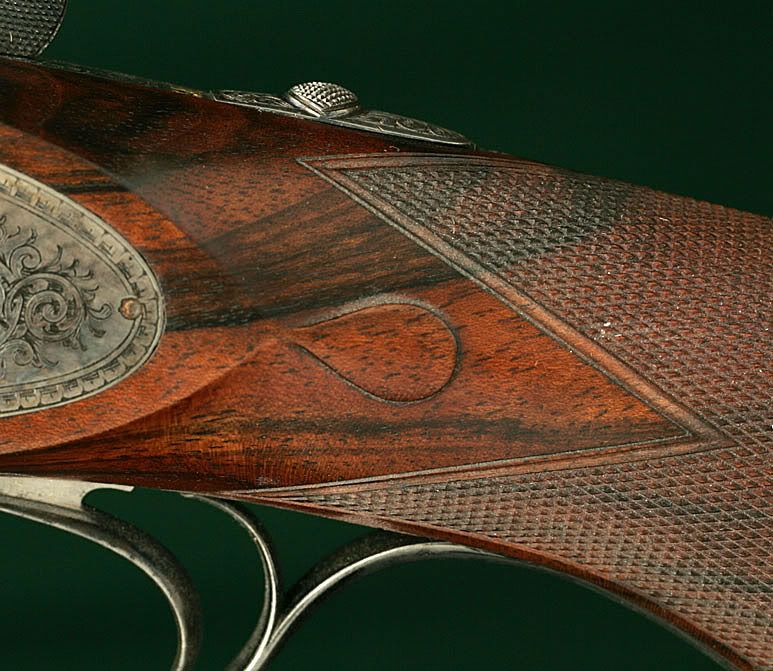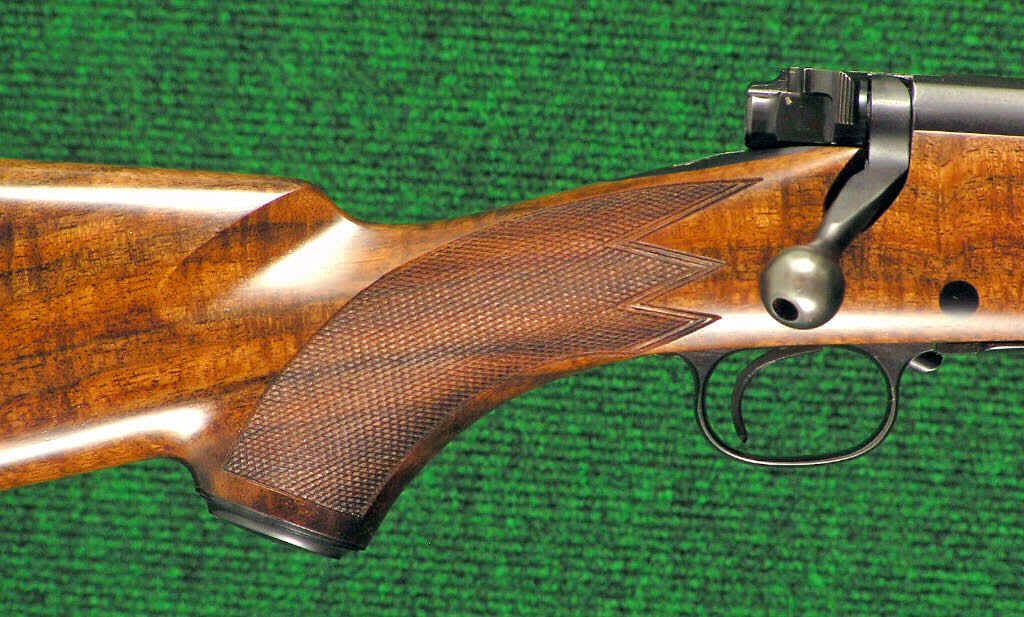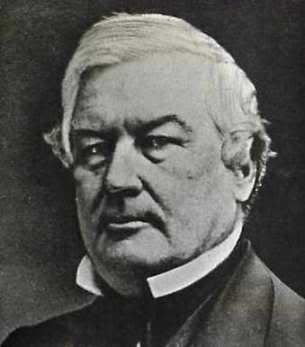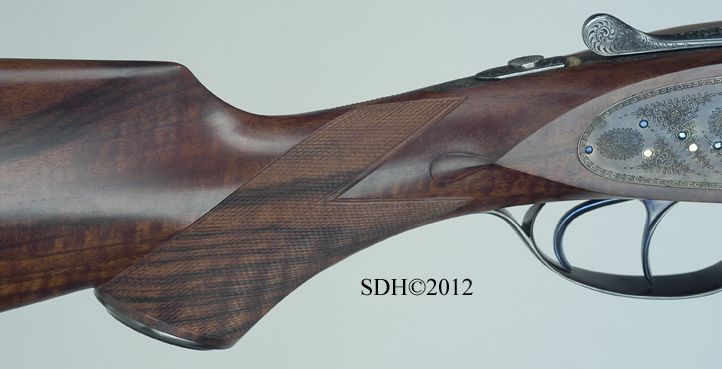

 The Accurate Reloading Forums
The Accurate Reloading Forums  THE ACCURATE RELOADING.COM FORUMS
THE ACCURATE RELOADING.COM FORUMS  Guns, Politics, Gunsmithing & Reloading
Guns, Politics, Gunsmithing & Reloading  Gunsmithing
Gunsmithing  mullered border
mullered borderGo  | New  | Find  | Notify  | Tools  | Reply  |  |
| new member |
Does any one know where I can purchase or how to make a tool for mullered borders on checkering gunstocks? The ones out of Brownells dont work really good for me and the ones from J&R's are to thin. I have been checkering for 15 years and the mullered border is becoming more and more popular. Thanks | ||
|
| One of Us |
Mike, email or call Kathy Forster. Her contact should be on the ACGG, if not call or email me. | |||
|
| new member |
Thanks Butch, I am new at this. I hope all has been going great. If this works I'll do you a checkering job for free. | |||
|
| One of Us |
I use a skew chisel, i.e. a small flat chisel with a backwards-slanted cutting edge. The chisel is held so that the forward edge is at the top, with the trailing edge at the bottom, and then the chisel is held at the proper angle to shave along the side of the border groove. Works on both sides if properly sharpened/used, and will clean up the ends of the slant-cut nicely without digging in like chisels with non-slanted cutting edges do. But Kathy may have a LOT better solution, try her! Regards, Joe __________________________ You can lead a human to logic but you can't make him think. NRA Life since 1976. God bless America! | |||
|
| One of Us |
Mullered Border - A style of boundary line at the edge of a checkered area on a gun stock. It is made by using a convex cutting tool which is slightly larger than the normal pointed checkering tool used for the body of the pattern. Typical of better English guns and of fine American guns built to evoke an English style. ? _____________________ Steve Traxson | |||
|
| One of Us |
Where did this term come from in gunmaking? | |||
|
| One of Us |
after a bit of research, I find "mullered" is a term for drunk, ruined or beaten. I'd guess it is a colorization or mispronunciation of an original word. | |||
|
| new member |
omg | |||
|
| One of Us |
pics-  http://www.hallowellco.com/mullered_borders.htm  http://www.cgm-gunstockcheckering.com/E2g.htm https://www.google.com/search?...LnT8fhDeGI6AHE8tHfDg  Mullered Fillmore, famous checkerer | |||
|
| One of Us |
_____________________ Steve Traxson | |||
|
| One of Us |
To the best of my knowledge, contemporary usage of the term "mullered" to describe a concave groove bordering a checkering pattern comes from author/gunmaker John Bivens in 1980s Rifle Mag articles. John was referring to an archaic wood carving term.  ACGG Life Member, since 1985 | |||
|
| One of Us |
Well, that is nice! The reason I put in the question mark is because I really didnt have an answer for Mike on his question. I was hopeing to see someone tell us how its done and with what kind of tooling. You know an answer to his question...I think it really adds to a pattern as shown in pictures. So, I have the same question, how do you do it and did you make your own tooling for it and if so...can we see it, Thanks! _____________________ Steve Traxson | |||
|
| One of Us |
I've seen it done with both a concave and a flat slanted treatment. I use a flat skew chisel for the flat treatment and have never done the concave one. However IMO the concave treatment would require two different chisels, one to be a mirror-image of the other. The front (cutting) edges would be slanted back at the same angle as the diamond pattern, i.e. either 3:1 or 3 1/2:1, and one chisel would cut from the left while the other would cut from the right. This right-side/left-side treatment is necessary in order to have the 2 sides of the trough meet at their ends without any unsightly gouges from a perpendicular cutting edge. Hmm...now I'm wondering if it would be possible to make both sides in one tool? When my bulging disc isn't bulging any longer, maybe I'll try. BTW, for a simple concave chisel, simply drill a slightly-smaller hole into the end of some small-dia round stock, then sharpen the inside edges and bend the shaft to shape, then grind the top half of the cutting end away to form a trough. Harden, anneal, sharpen, hone and cut. Regards, Joe __________________________ You can lead a human to logic but you can't make him think. NRA Life since 1976. God bless America! | |||
|
| new member |
That sounds like a really good idea. I am going to try this. Give me a little time and I will get back to you on this. I took a gunline straight line cutter and ground it down to a concave shape side to side. It works really well. I started out with a single line cutter to make a guide line. Then took a 3 line cutter to cut the lines off of that (lightly). Center line of 3 line cuter on top of the straight line cutter. Then took the modified gunline down the middle, so far works great. I need some more practice with it before I do it on my stock. I am going to try some of the other ways mentioned here also, I'll let you all know. Thanks alot | |||
|
| One of Us |
I use a Doiron carbide cutter in the electric tool and a W.E. Brownell concave hand tool. Will demonstrate at my Seminar in late July. It is really quite easy with the correct tooling. ACGG Life Member, since 1985 | |||
|
| One of Us |
Gunline makes a concave cutter. I have used it to make the center line disappear to make a mullered border. I also have some bent needle files of the 1/8" diameter which I ground off the pointed tip to make a top edge back slanted border making tool. Both work. Sometimes I must use both to get the pattern to lay in to proper depth and smoothness. Dennis Earl Smith Professional Member ACGG Benefactor Life NRA Life NAHC | |||
|
| new member |
I don't know how to thank you all for your help. This all gives me a lot of ways to tackle this issue. I hope the best for you all. Mike | |||
|
| Powered by Social Strata |
| Please Wait. Your request is being processed... |
|

Visit our on-line store for AR Memorabilia

